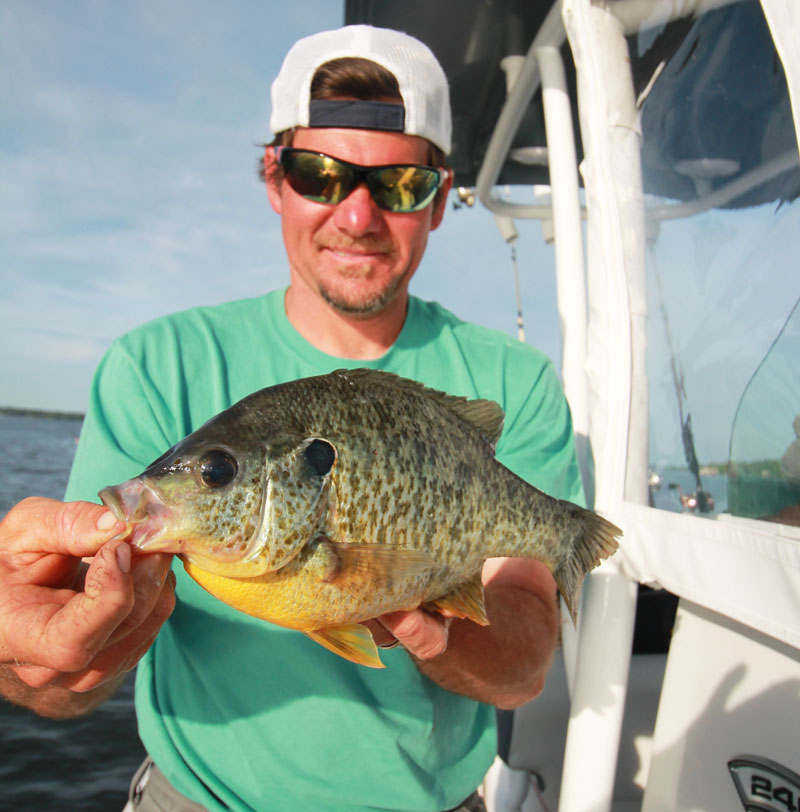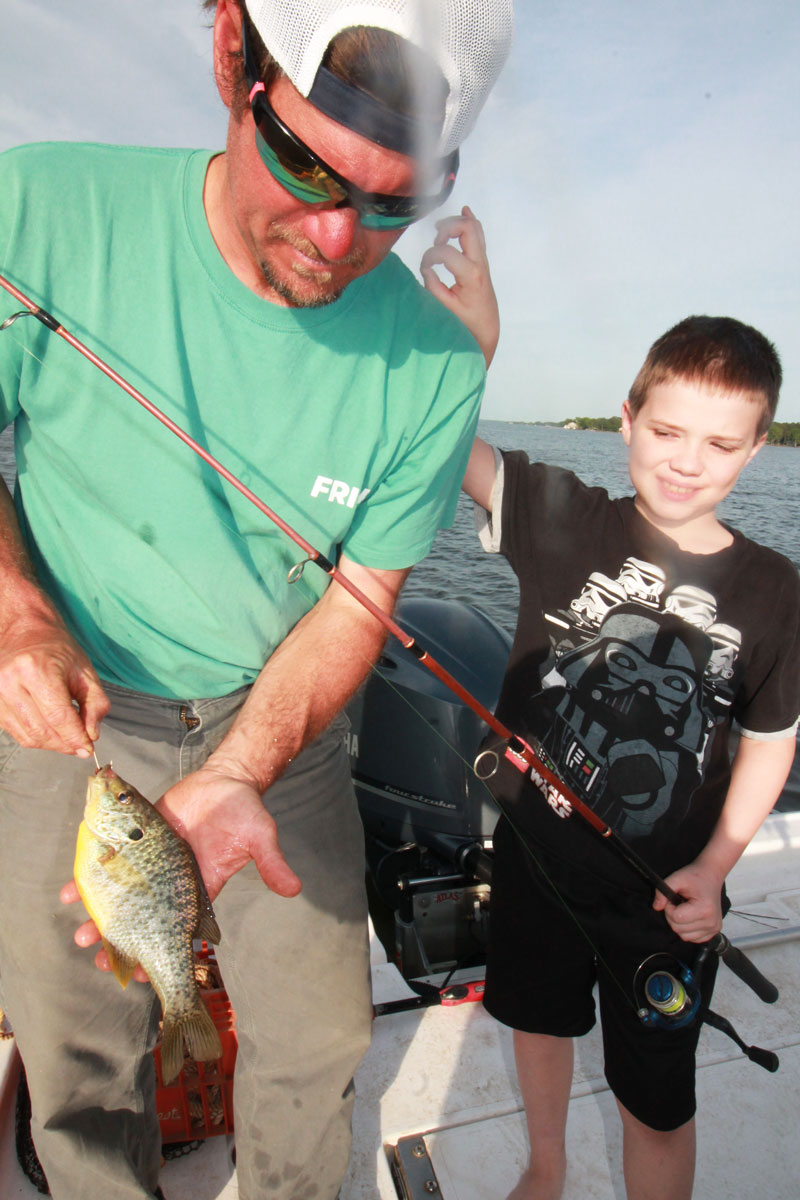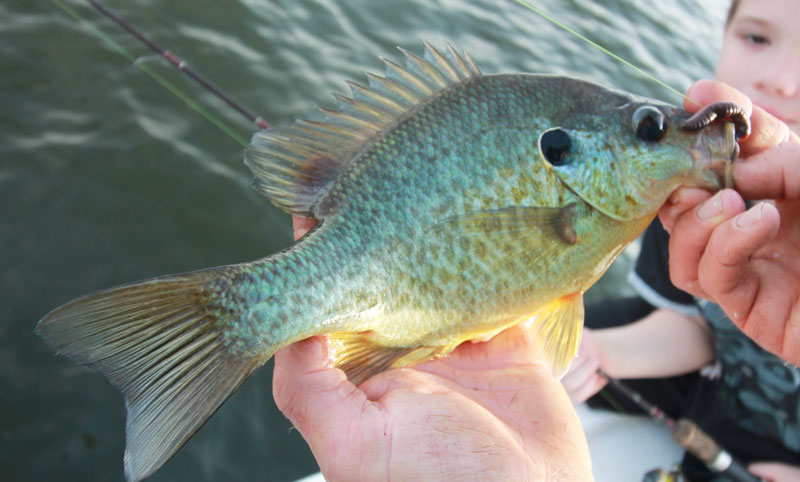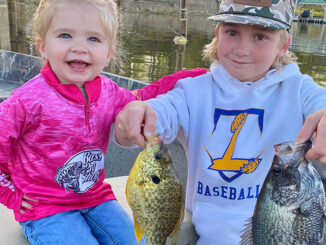
Shellcrackers have finished spawning on South Carolina’s Lake Murray and moved into deeper water, but that’s no reason to put away your worms and bream hooks. One guide says you can still fill your cooler very nicely.
As summer approaches, the legions of brightly colored shellcrackers that prowled the shallow water along the banks of South Carolina’s Lake Murray’s in April and May seem to have disappeared, but they have not gone far. They have just moved offshore into a little deeper water.
“By June, shellcrackers can be found in 10 to 20 feet of water, most in the 10- to 15-foot range, said guide Brad Taylor of Batesburg, S.C. “But I would not hesitate at all to fish for them as deep as 20 feet, and I have caught them that time of year in 21 to 22 feet of water.”
The short migration offshore is a part of the natural succession of reproduction on the lake during the spring, according to Ron Ahle, a fisheries biologist for the S.C. Department of Natural Resources.
“There is a seasonal sequence,” Ahle said. “Typically, the shellcrackers come in to spawn right at the tail end of the largemouth bass spawn. Then, after the shellcrackers spawn, here come the bluegills.”
Ahle said the spawning sequence occurs earlier from the middle part of the lake up to the Saluda and Little Saluda rivers because the water in that area warms faster than the lower part of the lake. Once shellcrackers, aka redear sunfish, leave the shallows, they will congregate on areas with a hard bottom, such as gravel or even rocks, ideally littered with woody debris such as stumps and sunken limbs.

By June, Taylor said, shellcrackers have finished spawning and settled into their summer pattern. They will stay in deeper water through summer and on into fall.
Once fish move offshore, Taylor targets them on the bottom with worms and just enough weight to get the bait down to the fish; his favorite outfit involves a slip cork because of the debris.
“When you reel in with the slip cork, the line runs through the cork; it allows you to pick the bait straight up off the bottom so you don’t get hung up in the limbs and other trash,” said Taylor, who fishes with 10-pound monofilament and a light-wire Aberdeen hook.
“Those fish do like cover, and that’s where that 10-pound line comes in handy,” he said. “When you do get hung up, it allows you to pull the hook out without breaking off. You actually bend the hook and pull it away from the debris.”
While crickets are top baits for bluegills, earthworms are the preferred bait for shellcrackers, but one particular type of worm is best, Taylor said.
“The most popular worms for shellcracker bait in this part of the world are blue worms, if you can get them,” he said. “Blue worms are a kind of worm that you dig out of the swamps around here. They are very hard to find, but hands down they are the best shellcracker bait. You can go to the standby worms — night crawlers and red worms — but you had better hope your buddy in the back of the boat doesn’t have a cup of blue worms, or he will outfish you.”
While a lot of people catch a lot of shellcrackers fishing from the bank, Taylor prefers to fish from a boat for a couple of reasons. First, he can anchor and put out a half-dozen or more lines with baits in different locations and at varying depths to cover a bigger area and, second, if the fish are not biting, he can move quickly to another spot.
“I like to fan-cast about six to eight rods around the boat and let them sit for a few minutes, and then move them,” Taylor said. “I like to pick out a target and know where my bait lands when I cast it out. Then, if I get a bite, I can re-bait and go right back to that same spot.”
It doesn’t take long to find out if a spot is going to produce fish, Taylor said. If they are there, you will be getting bites. If the baits sit idle for 15 or 20 minutes, it’s time to move to another spot.

Sometimes, he said, it’s a good idea to move frequently — catch one or two nice shellcrackers off a spot and then move to another spot so you don’t deplete the population in one area. And, he added, usually you catch bonus fish — such as bluegills, catfish and white perch — while targeting shellcrackers. One June day a year or two ago, he took a man fishing for shellcrackers to show him how to catch them in the summer.
“Every stop we made, we’d catch one or two shellcrackers, all of them pretty big — a pound or better — then we’d move to another spot. We also caught a catfish or two or a bluegill or two at every stop. When we came in, we had more than 20 big shellcrackers and a cooler also filled with catfish and bluegills — a really beautiful mess of fish.”
Taylor said the averagesize for a shellcracker on Lake Murray is probably around three-quarters of a pound, but it is not uncommon to catch fish up to 1½ to 2 pounds.
“The biggest one I ever caught myself was about 2½ pounds, but I have seen a shellcracker caught in Lake Murray that weighed 4½ pounds,” Taylor said.
Lake Murray shellcrackers healthy, numerous
South Carolina’s Lake Murray is blessed with a solid population of shellcrackers, and it is a healthy population, according to biologist Ron Ahle of the S.C. Department of Natural Resources. Although the agency does not sample shellcrackers in Lake Murray, the fish, along with other species, are often brought up to the surface when biologists do electrofishing sampling for largemouth bass in the spring, Ahle said.
“I can tell you there are a lot of shellcrackers in the lake, and they are pretty good-sized fish,” he said. “Quite a few will go to a pound or a pound-and-a-half, and there seem to be more of them this year than I have seen in a while.”
The fish they have sampled also appear to be very healthy, he said.
“They look good, very robust. When you are out there looking at all the different species, the shellcrackers are always impressive … probably because they are capable of eating snails and aquatic clams during the life stages of the clams — and the lake is loaded with those things.”
In fact, that’s where the fish gets its name. Shellcrackers have hard, bony plates in their throat which allow them to crush the shells of snails and mollusks. Shellcrackers go by other names, including Georgia bream, cherry gill, chinquapin, improved bream, rouge ear sunfish, sun perch and even stump knocker because of its preference for areas with rocky or gravel bottoms and woody debris.
Although a bass angler, Ahle said shellcrackers also hold a special allure. He used to keep a couple of ultralight outfits and a box of red worms on his boat just in case he runs into a congregation of shellcrackers.
“I’d catch a few few to carry home,” he said.
Is it a shellcracker or bluegill?
Shellcrackers, aka redear sunfish (Lepomis microlophus), are one of several prominent species of sunfish that inhabit lakes, river and ponds across the Carolinas, including bluegill, redbreast sunfish, green sunfish, pumpkinseed and warmouth.

Shellcrackers are easily distinguished from other species, especially bluegills, by examining the fish’s black ear flap. A shellcracker, will have a distinct edge around the ear flap; in males, it’s red, and in females, orange.
Shellcrackers also have distinct vertical bars along their flanks that are missing from other sunfish.
— Dan Kibler
DESTINATION INFORMATION
- HOW TO GET THERE — Accessing Lake Murray is easy via the location between Interstate 20 and Interstate 26. The major towns around the lake include Lexington, Chapin, Gilbert, Prosperity and Irmo. There are numerous launching ramps in any section of the lake you wish to fish. The shellcracker action is good lake wide but Guide Brad Taylor likes the middle to upper half of the lake because of more feeder creeks and small pockets which harbor shellcracker populations. Check maps sources below for details on how to reach a specific landing.
- WHEN TO GO — Shellcrackers can be caught year-round in Lake Murray. Although some anglers consider prime time to be during the spawn in April and May, some of the best fishing can be in June and through the summer months when the fish move a little further offshore into depths up to about 20 feet. Target hard bottoms with submerged woody cover.
- BEST TECHNIQUES — Fish night crawlers or red worms on the bottom in gravely or rocky areas with submerged woody cover. The absolute best baits are blue warms dug out of local swamps. Use enough weight to get the bait to the bottom and a slip cork so a retrieve will bring the hook straight up with less danger of getting snagged on stumps and submerged limbs.
- FISHING INFO/GUIDES — Brad Taylor, 803-331-1354, www.tayloroutdoors.com. See also Guides & Charters in Classifieds.
- ACCOMMODATIONS — Lake Murray Country, 803-781-5940, www.lakemurraycountry.com; RiverWinds Landing (camping), 803-364-0036, www.cabinrentalsonlakemurray.com; S.C. Department of Parks, Tourism and Recreation, 866-244-9339; South Carolina Association of Visitor Bureaus, www.discoversouthcarolina.com.
- MAPS — Navionics Electronic Charts, www.navionics.com; Delorme’s South Carolina Atlas & Gazetteer, 800-561-5105 or www.delorme.com; Kingfisher Maps, 800-326-0257, www.kfmaps.com.

